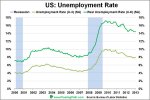- Joined
- Oct 27, 2011
- Messages
- 101,822
- Reaction score
- 45,418
- Gender
- Male
- Political Leaning
- Conservative
The different method of measurement that also shows unemployment rates dropping? Yes, how terrible for democrats.
Oh...it would be nice if the unemployment rate was the only important number...but it's not. The policies of Obama and the Congressional Democrats adversely affect issues other than that particular number.
btw, If I were a Democrat I wouldn't crow all that much about the unemployment rate. I mean...that number isn't THAT good. Especially after six freaking years.


